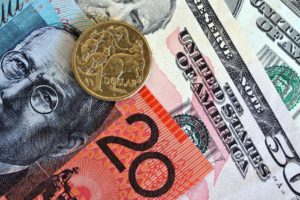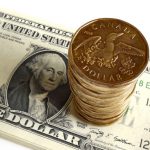 Australian dollar extended daily losses against its US counterpart during late US session on Friday ahead of Reserve Bank of Australias policy meeting next week and as prospects of maintained stimulus reduction by the Federal Reserve led to lower demand for high-yielding currencies, such as the Aussie.
Australian dollar extended daily losses against its US counterpart during late US session on Friday ahead of Reserve Bank of Australias policy meeting next week and as prospects of maintained stimulus reduction by the Federal Reserve led to lower demand for high-yielding currencies, such as the Aussie.
AUD/USD touched a new session low at 0.8916 at 20:20 GMT, after which the pair closed at 0.8928 on Friday, falling 0.42% for the day. AUD/USD registered a second consecutive weekly loss, losing 0.56% this week. Support was likely to be received at February 27th low, 0.8905, while resistance was to be met at Fridays session high, 0.8990.
Federal Reserve Chair Janet Yellen said that the central bank will probably continue with its plan to gradually reduce the scale of monthly asset purchases, while policy makers are trying to determine whether the weakness economy has recently demonstrated is due to temporal factors.
“Unseasonably cold weather has played some role,” she said in her testimony in front of the Senate Banking Committee on Thursday. “What we need to do, and will be doing in the weeks ahead, is to try to get a firmer handle on exactly how much of that set of soft data can be explained by weather and what portion, if any, is due to softer outlook.”
Yellen indicated that the Federal Reserve is abandoning its numerical threshold, that has linked any decision to increase borrowing costs to nation’s rate of unemployment. She also reiterated what the central bank has already said in a number of statements – that the scale back of monetary stimulus will continue at a “measured pace”, while the bond-purchasing program will likely be exited in the fall of the year.
Yesterday an official report made it clear that US economy expanded at a slower than initially projected pace during the final quarter of 2013, which suggested a more moderate development amid severe weather conditions in the country and a weaker demand for US goods and services abroad. Nations revised Gross Domestic Product increased at an annualized pace of 2.4% during the fourth quarter of 2013, or below the preliminary estimate pointing to a 3.2% expansion in economic growth. Experts had anticipated that US economy will grow 2.6% during Q4.
This data implied that nations growth was approaching levels, maintained in the quarters after the recession, with the rate remaining in proximity to 2%. However, other macroeconomic reports, released recently, including non-farm payrolls, housing sector activity, industrial output and consumer spending revealed a not so bright picture.
In addition, a separate report by the National Association of Realtors (NAR) showed that the index of pending home sales in the United States rose 0.1% in January compared to a month ago, remaining close to a two-year bottom. The report suggested that future housing market activity may slow down. Analysts had expected that pending home sales will increase 1.5% in January, following a revised up 5.8% drop in December.
According to NAR, weaker supply, severe winter and diminished ability of US consumers to make such purchases adversely influenced the overall result. A pending home sale is usually finalized within a period of two months.
Meanwhile, in Australia, private sector lending increased 0.4% in January compared to a month ago, while preliminary estimates pointed to a 0.5% gain. In annual terms, lending expanded 4.1% in January in line with expectations, following another 3.9% expansion in December.
Australian dollar lost ground against its major peers after the Bureau of Statistics reported on Thursday that private capital expenditures in the country, an indicator for future economic activity, declined 5.2% in the final quarter of 2013 compared to the third quarter, or the most since September 2009.
This data urged Citigroup Inc. to revise down its forecast regarding Australia’s Gross Domestic Product for the fourth quarter of 2013 to 0.4% from 0.6% previously. The company also projects a decline in spending by 25% during the next fiscal year.
Reserve Bank of Australia is expected to hold a meeting on monetary policy on March 4th. On Thursday traders saw a 36% probability that the central bank may reduce its benchmark interest rate from the current record low level of 2.50% by the end of August, swaps data compiled by Bloomberg News showed.
Elsewhere, the Aussie fell to lows unseen in one month against the euro on Friday. The pair touched a session high at 1.5493 at 20:04 GMT, also the highest level since January 31st, after which it closed at 1.5462 yesterday, surging 1.11% for the day, while recording a 0.99% weekly gain.
According to data by Eurostat, the annualized index of consumer prices in the single currency zone climbed to 0.8% in February, which exceeded expectations of a 0.7% inflation rate. However, the annualized inflation still remained far from European Central Banks inflation target of 2%, a level considered as providing price stability in the region. ECB policy makers are expected to hold their next meeting on policy on March 6th.
AUD/NZD dropped further on Friday, reaching a session low at 1.0629 at 14:53 GMT, or the lowest point since January 29th, after which the pair closed at 1.0649, down 0.61% for the day and also plummeting 1.75% this week.





